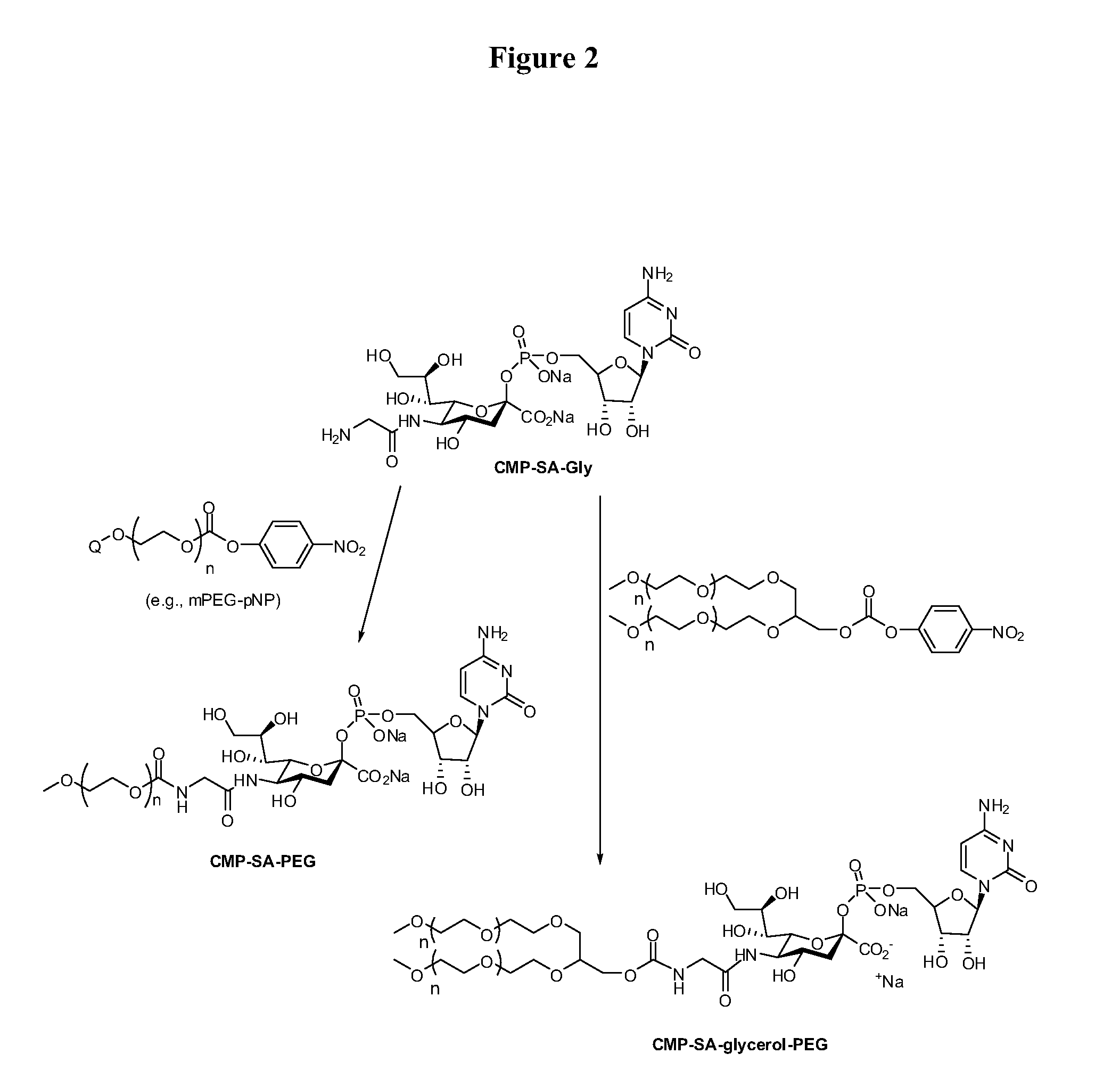Process for the production of nucleotide sugars
a nucleotide sugar and process technology, applied in the direction of sugar derivates, organic chemistry, chemistry apparatus and processes, etc., can solve the problems of undesirable presence of contaminants, often unfavorable large-scale applications of reverse-phase chromatography, etc., to reduce the formation of side-products and increase yield and purity for the final product.
- Summary
- Abstract
- Description
- Claims
- Application Information
AI Technical Summary
Benefits of technology
Problems solved by technology
Method used
Image
Examples
example 1
Preparation of CMP-SA-PEGs
1.1. Preparation of CMP-SA-PEGs-10 kDa
[0207]Cytidine-5′-monophospho-N-glycylsialic acid (CMP-SA-Glycine) disodium salt (1.23 g, 73.5 wt % pure, 1.34 mmol) was dissolved in Milli Q water (80 mL) in a 1 L single neck round bottom flask. The pH of the colorless solution was 10.48. Anhydrous THF was added (320 mL) and the pH was adjusted to 8.6 by the dropwise addition of 5.5 mL of 500 mM monosodium phosphate solution (pH 4.6). The 10 kDa mPEG-p-nitrophenyl carbonate (20 g, 2.0 mmol, 1.5 eq.) was then added in one portion to the reaction solution. After the PEG reagent had dissolved, the pH of the solution was 8.7. The yellow solution was stirred at 20° C. for 21 hrs. The pH of the reaction mixture was then adjusted from 7.8 to 8.5 by addition of 0.1 M NaOH (4.0 mL). The reaction mixture was stirred an additional 3 hours and the THF removed by evaporation under reduced pressure at 30° C. using a rotory evaporator. The evaporation was stopped when the volume of ...
example 2
Anion Exchange Chromatography of CMP-SA-PEGs
2.1. Column Packing Procedure for Q-sepharose Big Bead Resin (2L Scale)
[0210]Columns were prepared according to manufacturer's instructions. A representative procedure is described below:
[0211]An empty GE BPG 100 / 500 chromatography column was inspected for cleanliness and structural integrity. The bottom frit was wetted with water. The column outlet was plugged and 1-2 cm of the water was poured in the bottom of the column. Q-Sepharose Big Beads resin slurry in 20% ethanol (about 3.2 L, 65%) was resuspended to assure homogeneity. The resin slurry was poured slowly down the inside of the column to prevent air entrapment. After the resin slurry had been transferred to the column, the inside of the column was rinse using a squirt bottle containing 20% ethanol. The resin was allowed to settle for about 30 minutes, making sure that the height of the resin was about 3-5 cm higher than the desired height of 25 cm. (Add more resin if necessary). T...
example 3
Desalting Using Ultrafiltration
3.1. Tangential Flow Filtration of CMP-SA-glycerol-PEG-10 kDa Product Pool
[0218]The 1.5 L Q Sepharose Big Beads product pool according to Example 2.2 was desalted by tangential flow filtration (TFF) using the process parameters summarized in Table 1, below. A Masterflex L / S peristaltic pump was connected with silicone tubing (L / S 24) to a Millipore Pellicon-2 Mini Holder equipped with three Millipore 1 kDa Pellicon 2 “MINI” filters (PLAC-V 1 kDa Regenerated Cellulose Membrane; Screen Type: V; 0.1 m2). About 500 mL of the aqueous product solution was transferred to a 500 mL PETG bottle, which was immersed in an ice bath. The solution was stirred using a magnetic stir bar, and the temperature monitored and maintained at 14-16° C. throughout the process. Both the feed line and the retentate line were placed inside the PETG bottle on the TFF system. The remaining 1 L of solution, also chilled using an ice bath, was fed into the PETG bottle through another ...
PUM
| Property | Measurement | Unit |
|---|---|---|
| Fraction | aaaaa | aaaaa |
| Fraction | aaaaa | aaaaa |
| Fraction | aaaaa | aaaaa |
Abstract
Description
Claims
Application Information
 Login to View More
Login to View More - R&D
- Intellectual Property
- Life Sciences
- Materials
- Tech Scout
- Unparalleled Data Quality
- Higher Quality Content
- 60% Fewer Hallucinations
Browse by: Latest US Patents, China's latest patents, Technical Efficacy Thesaurus, Application Domain, Technology Topic, Popular Technical Reports.
© 2025 PatSnap. All rights reserved.Legal|Privacy policy|Modern Slavery Act Transparency Statement|Sitemap|About US| Contact US: help@patsnap.com



